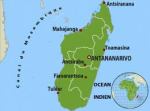
Ever wondered about the meaning of the name Antananarivo, the capital of Madagascar? Like: why does the ‘na‘ repeat itself twice (nana)? or whether this ‘nana‘ could mean mother or father or grandmother or grandfather as in many African languages, or ‘girl‘ in French? or could the ‘rivo‘ have something to do with river? or have you simply wondered why such a long name for a capital city?

Well, I have often wondered about Antananarivo because of the way its name falls from my mouth as if I was in a hurry, and then being rushed to say it quickly so as not to stumble. I have also wondered about its name, because it reminds me of the beauty of its country, Madagascar, the big island. Moreover, numerous neighborhoods in Cameroon have been renamed after the country because of its beauty and also I imagine, by respect for its people’s struggle for independence which was similar for the people of Cameroon.

The name Antananarivo means “the City of Thousand” with an meaning ‘to‘ or ‘at‘, tanan meaning ‘city‘, and (a)rivo meaning ‘thousand‘. Some think the ‘thousand’ is in reference to ‘thousand hills‘ or ‘thousand soldiers‘ in reference to the important royal Merina guard. In reality, Antananarivo was the site of a town called Analamanga, meaning ‘Blue Forest‘ in Malagasy. Analamanga was founded by the Vazimba people, the island’s first occupants. When King Andrianjaka of the Merina people moved into the area between 1610 and 1625, he deployed a garrison of 1,000 soldiers to successfully capture the city and guard the site. Declaring it his capital, Andrianjaka built a rova (fortified royal dwelling) that expanded to become the royal palaces of the Kingdom of Imerina. The site maintained its name Analamanga until it was renamed almost fifty years later by King Andriamasinavalona as Antananarivo, “City of the Thousand“, in honor of King Andrianjaka’s soldiers. People of Madagascar affectionately call it “Tana“, the city, and its named was frenchified during colonial time into Tananarive.

The city was first built as a fortress by the Merina Kings at the beginning of the 17th century, who made it the capital of the united Kingdom of Imerina in 1794. The community grew rapidly under the Merina Kings, and particularly under King Radama I whose control ultimately extended over a major part of the island, leading him to be considered the King of Madagascar by European diplomats, with Antananarivo as the island’s capital. Antananarivo remained the island’s capital after Madagascar was colonized by the French in 1897 , after the French military invaded Antananarivo on September 1894 causing major casualties amongst the Malagasy people, and causing queen Ranavalona III to surrender. Claiming the island as a colony, the French administration retained Antananarivo as its capital and transcribed its name as Tananarive. Antananarivo remained the capital of Madagascar after independence in 1960.

Today, Antananarivo is a vibrant city full of life, culture, and immense history. The city’s skyline is dominated by the rova of Antananarivo, which was destroyed in a 1995 fire but is under reconstruction. The nearby Andafiavaratra Palace was the home of 19th century Prime Minister Rainilaiarivony and currently contains a museum featuring historic artifacts of the Kingdom of Imerina. Downhill from the palaces is Andohalo square, where Merina kings and queens delivered speeches to the public. Tsimbazaza Zoo displays many of the island’s unique animal species and a complete skeleton of the now-extinct elephant bird. Other historic buildings include the Ambatondrafandrana tribunal where Ranavalona I dispensed judgement, the second residence of Rainilaiarivony with its indigenous medicinal plant garden, the recently renovated Soarano railroad station, four late 19th century memorial churches built to commemorate early Malagasy Christian martyrs, the tomb of Prime Minister Rainiharo, and the early 20th century pavilions of the Analakely market. Enjoy the video below, and if you are ever in Madagascar, please do visit the beautiful Tana, the capital of the great Merina Kings, named to celebrate a thousand courageous soldiers and the beautiful hills of the central highlands.


I haven’t focused that much about Madagascar, but that’s great to know about the city Antananarivo. It looks like a great city and I wish people who saw THAT Dreamworks movie series would research this and to have a reality check.
LikeLike
Do you what? I am an Indonesian, and in Indonesian language, “tanah” is land in English, “ribu” is “thousand”. It’s very likely as you described, “tana” is actually “tanah” which means “land” in English. In the old day, say 300-400 years ago, the concept of city that we understand today certainly didn’t exist, I think people used the term “tanah” or “tana”, which means land, to a certain inhabited area or region. And “rivo” sounds very close to “ribu” which means thousand.
LikeLike
Thank you Ru Pu for the addition, especially linking it to Indonesian. This is very informative. Yes… indeed in the olden days, people referred to city more as ‘land’ or ‘place’.
LikeLike
Exactly, Malagasy are Austronesian, a family that covers an area of 15 nautical time zones from Rapa Nui in Chile to New Zealand (Maori) to Hawaii, Taiwan (Aboriginals), Philippines, Indonesia, Malaysia, and Madagascar in Africa.
In all of those languages, “thousand” sounds something like “ribu”.
Btw, “O” in Malagasy is pronounced like “U”, thus “rivo” is pronounced as “rivu”.
LikeLike
Thanks for the information Qris… I appreciate it.
LikeLike